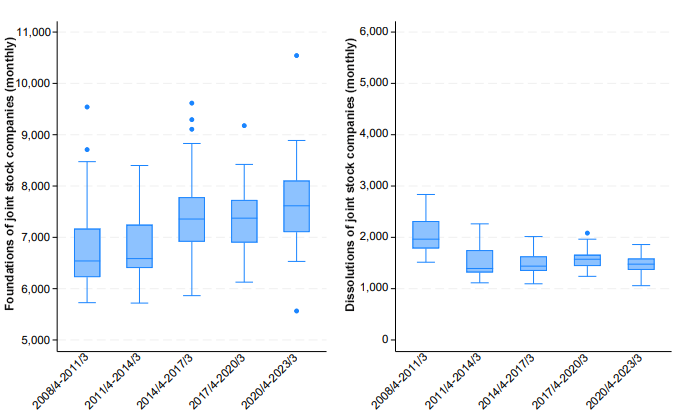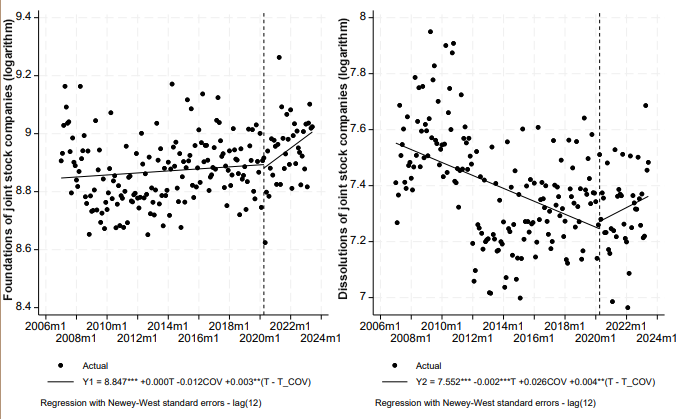Business entries and exits stimulate industrial and economic revitalization and allow for the effective functioning of market mechanisms. In general, business entries and exits are positively correlated. Both are active in a growing industry or economy (Honjo, 2010; Geroski, 1995). According to the White Paper on Small and Medium Enterprises, however, business entry and exit rates in Japan have remained low compared to international levels (Small and Medium Enterprise Agency, 2023). The promotion of business entries and exits, including the creation of start-ups, is a very important policy goal as it has a significant effect on industrial and economic revitalization.
Have business entries decreased during the COVID-19 crisis?
On March 13, 2020, the Act on Special Measures against the New Coronavirus (the act partially amending the Act on Special Measures against New Influenza, etc.) was enacted. On April 7, a state of emergency was declared under Article 32 of the Act. The number of joint stock companies founded (registered) in Japan in May 2020 stood at 5,565, down 28% from 7,769 in the same month of the previous year. The monthly number slipped below the November 2008 level, which was affected by the 2008 global financial crisis. This represents the lowest level since January 2007, which is the starting point for measurement in this study.
To the best of my knowledge, the effect of the COVID-19 pandemic on business entries and exits in Japan has not been sufficiently verified. Therefore, I would like to clarify the actual situation of business entries and exits for joint stock companies, which are representative organizations in terms of economic activity in Japan. The data used here are from commercial entity registration statistics provided by the Ministry of Justice, covering the period between January 2007 and June 2023 (Note 1).
Figure 1 shows a boxplot of monthly numbers of foundations and dissolutions of joint stock companies in the COVID-19 pandemic period and four earlier 36-month periods. Given that the government declared a state of emergency in April 2020 in response to the COVID-19 pandemic and downgraded COVID-19 to the Category 5 infectious disease in May 2023, I designated the COVID-19 pandemic period as 36 months or three years between April 2020 and March 2023 and compared data for that period with the data for the other four previous 36-month periods (Note 2). As shown in Figure 1, as far as the median and quartile ranges are concerned, foundations did not decrease during the COVID-19 pandemic period (between April 2020 and March 2023) from the earlier periods. In fact, there was a slight increase. The decline in May 2020 was temporary. On average, there was no decline from the earlier periods. Furthermore, according to the White Paper on Small and Medium-sized Enterprises, the business entry rate for business establishments with employees was 5.1% in 2020 and 4.4% in 2021, exceeding the 4.2% recorded in 2019 (Small and Medium Enterprise Agency, 2023). On the other hand, business exits remained stagnant during the entire observation period. During the COVID-19 pandemic period, business exits did not increase.

Did the business entry and exit trend change?
For the observation period from January 2007 to May 2023, I used trend terms to regress foundations and dissolutions (logarithmic scale). The trend term coefficient was positive and significant for foundations. Conversely, it was negative and significant for dissolutions (Note 3). Based on the results, I used interrupted time-series analysis to indicate trend changes attributable to the spread of COVID-19 in Figure 2. In Figure 2, I used business entries (logarithmic scale of foundations) and exits (logarithmic scale of dissolutions) as dependent variables and paid attention to trend changes since April 2020. As shown in Figure 2, foundations and dissolutions of joint stock companies had positive trend terms during the COVID-19 period. There was no decline in business entries (foundations) during this period.

Business entries did not decline during the COVID-19 period
As indicated above, there is no evidence that the COVID-19 spread hindered the creation of business start-ups. While several industries, such as accommodation and food services, were sluggish, the number of business entries did not decrease in Japan as a whole. One reason for this was the spread of economic activities under the new normal, including telecommuting and online meetings, which led to the creation of new business opportunities in such fields as information and communications, and medical diagnosis. In addition, emergency economic measures to counter the spread of COVID-19 and the promotion of start-ups in recent years may have supported business entries.
On the other hand, dissolutions decreased during the COVID-19 period as shown in Figure 1. Within the period, however, there was a slight upward trend. In May 2020, private financial institutions under the government’s economic measures suppressed unprofitable businesses’ exits through effectively interest-free, unsecured loans. From July 2023, however, the number of business exits (dissolutions) is expected to increase due to the concentration of repayments of such loans (Note 4).
After the bursting of the bubble economy, industrial and economic stagnation continued in Japan, leading to a decrease in the number of business entries and exits. Although it was thought that the COVID-19 spread contributed to decreasing the number of business entries, surprisingly, no decrease was seen. I hope that the absence of any decrease in business entries under the pandemic will help to promote revitalization of the Japanese economy through business entries and exists.
September 6, 2023
>> Original text in Japanese


